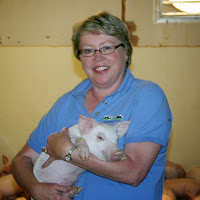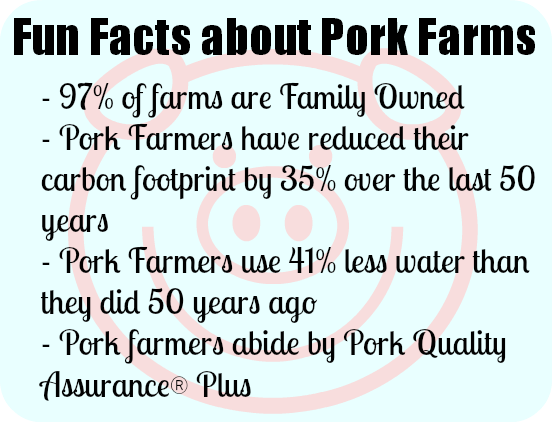
We may earn money from the companies or products mentioned in this post.
*This post is sponsored by The National Pork Producers Council. All opinions are my own*
Last week I had the opportunity to listen in on a discussion with family farmers Chris Chen and Wanda Patsche, as well as Swine Vet Meghan Pierdon. The experience and information was eye opening to me as a consumer. As the daughter of two parents who were raised on farms, I am fascinated by where our food comes from, and the process they must go through to get it to my table,
Meet the Farmers
Chris Chinn is a 5th generation family farmer. With the help of her husband Kevin, his parents and brother, and their two children, they raise hogs, cattle, hay and row crops. Earlier this year Chris was named one of the U.S. Farmers & Ranchers Alliance “Faces of Farming and Ranching”. While we spoke, Chris was in the process of making feed for the pigs. Follow Chris online at her blog Chris Chinn.
Wanda Patsche is a wife, mother, and grandmother. She and her husband Chuck have been raising hogs, corn and soybeans on their farm in Minnesota for 35 years. In 2012 Wanda’s family received the Minnesota Pork Farm Family of the Year award, honoring their contribution of at least 20 years in the pork industry and leadership and pork promotion on the local and/or state levels. You can find her online at Minnesota Farm Living
Meet the Vet
Meghann Pierdon, DVM is a mom of two and swine veterinarian. She currently works as an animal welfare resident at the University of Pennsylvania School of Veterinary Medicine. She has her Veterinary Medical Degree from the University of Pennsylvania and a B.A. in Biology from Wellesly College.
Antibiotic Use in Pigs
The biggest thing I felt I came away with from this discussion is how labels on some meats are very misleading. We hear about buying organic, and antibiotic free meat, but the reality is all meat is antibiotic free. The FDA has set strict withdrawal periods between the last dose of an antibiotic and when an animal can be sent to market. If farmers aren’t following the guidelines they could be blacklisted and lose their farms. All antibiotics used with the meat are approved first by the FDA.
Why do the farmers use antibiotics in the first place? Despite plenty of preventative measures, viruses can still happen. For the farmers it comes down to the choice of losing the pig due to illness or saving it with medications that will eventually leave their system. Farmers like Chris and Wanda work closely with their veterinarians to protect the hogs from potential virus, and then treat them on an individual basis when sickness does hit.
On the farm there is minimal testing for antibiotics in the pigs, but records are kept when antibiotics are administered and what the withdrawal period is for each medicine. More testing is done at the packing plant. Animals are randomly picked and tested from different groups to get an overall idea of what those pigs have been treated with, and if it is still present in the meat. If a pig is showing signs of illness in the packing plant, they will be pulled and tested, as they have more likely been treated recently.
I suggest reading this article by Chris Chinn “Why my Hogs are on a healthcare plan” for a more detailed look into the myths surrounding antibiotic use.
Free Range verse Inside
Most farmers are moving their hogs from Free Range, to indoor facilities. There’s been hype for years on this on how unsanitary this is, and diseases will spread more because of the close quarters. After talking to Wanda and Chris, I again, had an eye opener. I truly thought animals would be happier in the outdoors, but I’m not a farmer. I don’t spend day in and out with these animals (though I’d love to live on a farm), so I have no professional background for my thoughts.
By moving the hogs inside the families have been able to cut out predator attacks. Because of the controlled environment, the farmers are able to better prevent the diseases picked up by the hogs, and can better contain the pigs and treat them before it spreads. By taking away the hay, it also cuts down a lot of the bacteria that could grow. The pigs waste is also then tested and used to fertilize the fields.
Thanks to this open discussion with the farmers, I feel so much better about feeding my family pork – even without the antibiotic free/organic labels.

